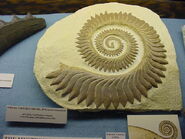| Helicoprion Fossil range: Late Carboniferous-Early Jurassic | |
|---|---|
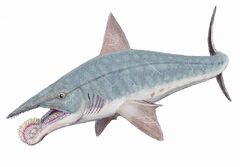 Artist's hypothetical rendition of Helicoprion bessonovi. | |
| Scientific classification
| |
|
Helicoprion | |
| |
Helicoprion (meaning "Spiral Saw") is an extinct genus of whorl-toothed ratfish that first arose in the oceans of the Late Carboniferous, approximately 280 million years ago, and survived the Permian-Triassic extinction event, and eventually went extinct during the Early Triassic, some 225 million years ago. Its fossils can be found in Russia and in the Western U.S. but no other part of the jaw or shark has ever been found.
The type species, H. bessonovi, was discovered and described in the Ural Mountains of Russia in 1899 by Russian paleontologist Andrzej P. Karpinski. The type specimen is a holotype based upon a single tooth-whorl. The tooth-whorl has puzzled paleontologists for decades, as it was unknown as to where it fit into the jaw, until a modern reconstruction determined that the most feasible place was within the shark's mouth.
Helicoprion is a member of the Order Eugeneodontida, members of which possessed a unique "tooth-worl" on the symphysis of the lower jaw as well as pectoral fins supported by long radials, and is closely related to Edestus. The most famous fossil specimens of Helicoprion are found in eastern Idaho, northern Utah, and the far central western part of Wyoming.
History[]
At first, specimens of H. bessonowi were thought to be the coiled shell of a somewhat odd ammonite. On closer inspection, it was discovered that they were a continuous whorl of teeth or perhaps dermal denticles from some kind of shark. In short order, the creature was named Helicoprion.
Russian paleontologist Andrzej P. Karpinski who was the first to find and describe a specimen, which he collected in 1899 in the Ural Mountains, invested years of his life in futile attempts to restore the position of the whorl, illustrating various possible positions of the tooth-whorl, from the top of the first dorsal fin, to hanging it from the tip of the tail, as well as placing the whorl on the tip of its nose.
Only a year after Karpinsky's description appeared in print, American paleontologist C. R. Eastman wrote: "Of the two leading theories as to the position of ... `spines' the first ascribes them to the jaws of a shark or skate, and the other to the median line of the back, some distance in advance of the dorsal fin." In a 1952 analysis of the tooth whorl, Russian paleoichthyologist Dimitri Obruchev decided that a location in the lower jaw "would only prevent the fish from feeding." He therefore placed the whorl in the upper jaw, "where it could serve as effective protection" acting as a shock absorber for the animal's head.
It was not until the discovery of the skull of a relative, Ornithoprion, that it was realized that the tooth-whorl was in the lower jaw.
Paleobiology[]
The tooth-whorl represented all of the teeth produced by that individual in the lower jaw, in that as the individual grew, with the older, smaller teeth being moved into the center of the whorl by the appearance of larger, newer teeth. Comparisons with other eugenodontids suggest that Helicoprion may have grown up to 10-15 feet long.
Fossils[]
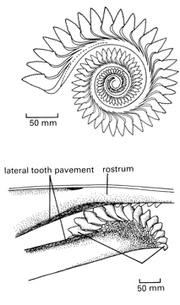
Helicoprion tooth whorl (from Benton, 2005)
Fossils of Helicoprion bessonovi have been found in mid-Permian deposits in Russia, North America, Japan, and Australia[1], and, more recently, the Gufo Mountain one mile south of Zhijin city in Guizhou Province, China. A Helicoprion tooth whorl has also been discovered in the Late Permian Van Haven Formation, Ellesmere Island, the same area where Tiktaalik fossils were found.[2]
Curious spiral structures, some 10 inches (26 centimeters) across - or about the size of a large dinner plate, characterize this genus.
In Eurasia, this taxon has been collected in Spitsbergen (Nassichuk, 1971), on the western flank of the Ural Mountains (Karpinsky in Wheeler, 1939), Pakistan (Koken in Chom, 1978), Indochina (Hoffet, 1933), Japan (Yabe in Teichert, 1940), and possibly Iran (Obruchev in Chorn, 1978).
As for the Southern Hemisphere, Helicoprion has not been found in South America nor in Africa, although it is known to occur in several outcrops in western Australia (Teichert, 1940). In the North American region it has been reported from the Canadian Arctic and Alberta[3] (Wheeler, 1939; Logan and McGugan, 1968; Nassichuk, 1971), British Columbia (Henderson and McGugan, 1987), Idaho (Williams and Dunkle, 1948; Bendix-Almgreen, 1966; Foss, 1980), California and Nevada (Wheeler, 1939), and Texas (Kelly and Zangerl, 1976; Chorn, 1978)[4]. This last report from Texas has been referred to the Wolfcampian (Kelly and Zangerl, 1976), making it the oldest record of this taxon worldwide.[5]
In Mexico the presence of Helicoprion has been reported in the northern states of Coahuila (Millerried, 1945) and Chihuahua (Bridges and DeFord, 1962). Over 30 years after the last report of Helicoprion in this country, a third specimen of this taxon was collected in the State of Puebla, which represents the southernmost record in the Western Hemisphere. Recently, in March of 2000, a Helicoprion specimen from the Patlanoaya Formation, State of Puebla, Mexico, represents the southernmost finding of this genus of edestoid-shark in the Western Hemisphere.[6] It consists of one broken symphysial whorl dental piece, 12 cm in diameter.[7]
Teeth[]
The individual teeth are serrated, and it's implied that Helicoprion was carnivorous. As there has yet to be an actual skull found, exactly how it captured or fed on its prey are subjected to a great deal of speculation. One hypothesis that it preyed on ammonites and that the teeth were specialized for the job of breaking into the ammonites' shells. Another idea was that the shark would swim into a school of fish and fling out the jaw, snagging prey on its many teeth. The most famous specimens of Helicoprion are found in eastern Idaho, northern Utah, and the far central western part of Wyoming.
Relationship with Edestus[]
It is now generally agreed that the structure is indeed a complex whorl composed of up to 180 teeth and must therefore have fit somehow into the mouth. Further specimens revealed that the teeth of Helicoprion most closely resembled those of a group of Paleozoic sharks known as edestoids.[8] One of the best-known species, Edestus giganteus, was a 20-foot (6-meter) super-predator (about the same size of the modern white shark) with teeth that kept growing beyond the tip of its snout. The most likely orientation - based on the teeth of Edestus and related edestoid sharks - is that the teeth overhang from the lower jaw like the vertical blade of a circular saw, having coiled about themselves as new teeth were generated from behind. It is possible that Helicoprion used this buzz-saw arrangement to snag squid-like creatures with a sideways swipe of the head while swimming through a school of the soft-bodied molluscs. In any case, Helicoprion exemplifies some of the difficulties involved in reconstructing ancient creatures from only a few clues.
Restorations[]
A common question regarding Helicoprion is which of many life restorations found on the internet and in the scientific literature are correct? One restoration has the tooth whorl hanging out of the center of the lower jaw; another has the tooth whorl in the center on the inside of the lower jaw; still another has it set back in the lower jaw looking like a buzz saw; still another shows a spiral dentition in both the upper and lower jaw.
History[]
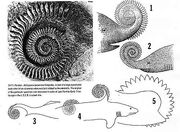
Andrzej P. Karpinski's illustrations showing the various hypothetical placement of the tooth-whorl.
Helicoprion was first described in 1899 by A. Karpinsky on the basis of an incomplete specimen from the Permian of the region of Russia. He believed that this dentition hung out of the shark’s upper jaw. In his review of this paper, Charles R. Eastman (1900) stated that the teeth were spines positioned in front of the dorsal fin on the shark’s back. Both of these interpretations would have created drag and generated vibrations (see gallery below).
In his 1995 book The Rise of Fishes: 500 Million Years of Evolution, John A. Long, curator of vertebrate paleontology at the Western Australian Museum in Perth, includes a hypothetical illustration of Helicoprion that shows the shark's lower jaw curling downward into a tooth-studded spiral. One could imagine that the shark uncoiled its jaw and lashed at prey with a sort of toothed whip. Another theory is that Helicoprion's tooth spiral mimicked coiled shellfish called ammonites (especially abundant at the time) in order to attract these ammonites, the shark's prey. "It seems more likely," Long writes, "that these sharks used the jagged tooth-whorls when charging into a school of fish or ammonites and thrashing about to snag prey on the projecting array of teeth".
Richard Lund, a paleoichthyologist at Adelphi University and an expert on sharks from the Devonian Period, points out two of Helicoprion's radical features: the disproportionate size of the teeth making up the whorl, and the bases of the teeth being locked together during growth, a feature that prevented the shedding of the teeth. "Thus the smaller and older teeth are just shoved out and down, sort of like an ingrown toenail, only with teeth." Lund also believes the spiral must have been proportional to the size of the jaw that supported it: "Any reconstruction of the fish itself must be big enough to accommodate, smoothly, a buzz-saw-like gadget that got up to three feet in diameter. This yields a fish of very impressive size as well as impressive dentures."
Ray Troll is known by fossil shark experts for having studied Helicoprion for many years. His illustrations of Helicoprion (as well as a beautiful life-size model by Gary Staub based on Ray’s illustrations) can be seen on the internet. However, it is widely accepted now that the Ray Troll illustration is incorrect.
Early restorations[]
It was eventually decided that no previously published reconstruction of Helicoprion could be used as a reference for an accurate model. A puzzling question is why would a new spiral form of tooth replacement for jaw teeth develop in a Permian shark when an efficient method for tooth replacement (non-spiral) had already evolved in sharks prior to the Permian?
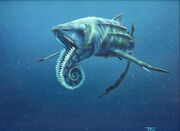
Most current reconstructions are based upon the Bendix-Almgreen’s (1966) interpretations of crushed specimens of the edestoid sharks Sarcoprion and Helicoprion. (Edestoid sharks have an arched or spiral series of teeth, which are usually the only portions of the sharks’ remains preserved as fossils.) None of the specimens used by Bendix-Almgreen to interpret the anatomical position of these dentitions possessed landmarks that would allow the identification of specific cranial cartilage. The reconstructions are based on the assumption that the dentitions were symphyseal ones (point where left and right jaws meet) in the upper and lower jaws.
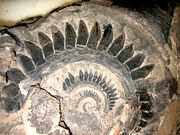
This is a typical fossil tooth whorl of Helicoprion. This fossil is USNM 22577.
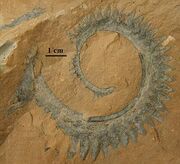
Tooth whorl of Helicoprion nevadensis.
In 1902 Eastman described a new Carboniferous edestoid shark dentition (Campodus variabilis) that he described (p. 150) as "three series of coalesced anterior or symphyseal teeth." He considered this specimen as evidence that the spiral dentition of Helicoprion was symphyseal. Because Eastman’s specimen was not associated with skeletal remains, its position in the shark’s body could not be ascertained.
In 1912, O. P. Hay published a new species of Edestus based upon the articulated upper and lower arched dentitions. This was the first known edestoid specimen with associated upper and lower dentitions. He interpreted them as belonging to the symphyseal region of the upper and lower jaws; the specimen, however, did not possess any cartilage that could be identified with certainty to its position in the cranium. He did not consider the possibility that the dentition was branchial.
From the time of Hay’s paper (1912) until the present, paleontologists have assumed that the tooth whorls of Helicoprion and similar dentitions in other edestoids were jaw dentitions (see Zangerl, 1981:86), but no skeletal evidence existed to support their position.
Bendix-Almgreen (1966) studied several spiral dentitions of Helicoprion that had cartilage surrounding them. Although the cartilage possessed no landmarks to identify it as cranial cartilage, Bendix-Almgreen stated that the cartilage represented the jaws and that the spiral dentition was from the symphyseal region of the jaws. This interpretation creates the following problems:
1. As Bendix-Almgreen noted (1966:30) the teeth in these specimens show no sign of wear or breakage. Based on whole shark specimens, it appears that tooth replacement was slower in Paleozoic sharks than in living sharks (Williams, 2001). Jaw dentitions of Paleozoic sharks often exhibit tooth wear and breakage; in living sharks tooth wear and breakage are rare. This absence of wear and breakage in Helicoprion (a Paleozoic shark) suggests that the teeth were not used for biting.
2. If spiral dentitions were in jaw positions two problems arise. To understand one of these problems we have to know something about how sharks replace their teeth. Many sharks have a total of 50 or more teeth in their upper and lower jaws; each tooth in a biting position is followed by 3 or more teeth in varying stages of development. The innermost teeth are the youngest and least formed and the outermost or biting teeth are complete. In Devonian sharks (which are older than Helicoprion), Williams (2001) found that these sharks, unlike living sharks, did not shed their teeth but retained them on the outside of the jaws under the skin. The pressure of the succeeding tooth pushes the no longer functional teeth into bunches forming bumps around the head. With this method of tooth replacement, retaining dentitions in spiral forms suggest that the jaws or the skin surrounding them would have been significantly modified to preserve the dentition in this manner. The result would be a large bulge on the underside of the jaw, about 62 cm., (2 feet). Bio-mechanically this would require extreme adaptations for which there is no evidence.

Modern reconstruction of Helicoprion showing how the tooth-whorl may have been situated in the jaw.
The second problem is with the largest teeth pointing toward the throat the older teeth would hang out of the jaws. This would create drag and generate waves through the water that would warn prey of the shark's presence. Helicoprion would lose the advantage (that evolved in their ancestors) of the placoid scales that cover their bodies. These scales, which look like squat, bent teeth, allow water to pass over the shark’s body without generating any waves. A fish nearby would not know the shark was coming. This adaptation seems unlikely, and no evidence exists yet to show that the spiral dentition occupied a jaw position.
Modern restorations[]
Where then does the dentition reside? A possible position is the throat cavity; this cavity could accommodate the dentition’s spiral form, and the dentition would not be subjected to the wear and breakage from biting prey that would occur in a jaw position. In the throat cavity, this dentition was probably supported by the cartilage between the basal margins of the right and left gill arches in sharks. New teeth for the spiral dentition probably originated on this basal cartilage. The teeth may be modified pharyngeal denticles, which occur on the gill arches and basal cartilage in sharks and other fishes. As a throat dentition, when the shark opens its jaws, the teeth would be presented to grab prey entering the mouth cavity. Closing the jaws, the teeth would move the prey toward the esophagus. This type of dentition would work well for catching soft-bodied prey.
Mary Parrish, scientific illustrator, reconstructed a Helicopiron with the spiral dentition in the throat. In Mary’s reconstruction, the jaw teeth are rounded bars. These have not been found yet associated with Helicoprion, but other edestoid sharks have jaw teeth like these. It is gennerally thought that Helicoprion probably had similar teeth in its jaws.
See also[]
References[]
- ^ TEICHERT, C. 1940. Helicoprion in the Permian of Western Australia. Journal of Paleontology, 14:140-149.
- ^ SPIRAL TEETH
- ^ NASSICHUK, W. W. 1971. Helicoprion and Physonemus, Permian vertebrates from the Assistance Formation, Canadian Arctic archipelago. Canada Geological Survey Bulletin, 192:83-93.
- ^ KELLY, A A., AND R. ZANGERL. 1976. Helicoprion (Edestidae) in the Permian of West Texas. Journal of Paleontology, 50:992-994. LOGAN, A., AND A. McGUGAN. 1968. Biostratigraphy and faunas of the Permian Ishbel Group, Canadian Rocky Mountains. Journal of Paleontology, 42(5):1123-1139.
- ^ Sour-Tovar, Franciso, Quiroz-Barroso, Sara A, Applegate, Shelton P. "Presence of Helicoprion (chondrichthyes, Elasmobranchii) in the Permian Patlanoaya formation, Puebla, Mexico". Journal of Paleontology , March 2000.
- ^ RIDGES, L. W., AND R. K. DEFoRD. 1962. Pre-Carboniferous Paleozoic Rocks in Central Chihuahua, Mexico. American Association of Petroleum Geologist Bulletin, 45:98-104.
- ^ RIDGES, L. W., AND R. K. DEFoRD. 1962. Pre-Carboniferous Paleozoic Rocks in Central Chihuahua, Mexico. American Association of Petroleum Geologist Bulletin, 45:98-104.
- ^ HAY, 0. P 1909. On the nature of Edestus and related genera, with description of one new genus and three new species. United States National Museum Proceedings, 37(1699):43-61.
- Bendix-Almgreem, S. E., 1966. New investigations on Helicoprion from the Phosphoria
Formation of south-east Idaho, U.S.A. Biologiske Skrifter undgivet af det Kongelige Danske Videnskabernes Selkab, v. 14, n. 5, pp.1-54, pl. 1-15.
- Eastman, C. R., 1900. Karpinsky’s genus Helicoprion. A review. American Naturalist, v. 34, p. 579-582.
- Eaton, Jr., T. H., 1962. Teeth of edestid sharks. University of Kansas Publications, Museum of
Natural History, v. 12, n. 8, pp. 347-362, 10 figs.
- Hay, O. P., 1912. On an important specimens of Edestus; with description of a new species,
Edestus mirus. Proceedings of the U. S. National Museum, v. 42, n. 1884, pp. 31-38, pl. 1, 2. Peyer, Bernhard, 1968. Comparative Odontology. The University of Chicago Press, pp.1-347, pl.1-96
- Williams, M. E., 2001. Tooth retention in cladodont sharks: with comparison between primitive grasping and swallowing, and modern cutting and gouging feeding mechanisms. Journal of Vertebrate Paleontology, v. 21, n. 2, p. 214-226.
- Zangerl, R., 1981.Chondrichthyes I: Paleozoic Elasmobranchii. In H. P. Schultze (ed.), Handbook of Paleoichthyology. Gustav Fischer Verlag, New York, 115 pp.
External links[]
- Prehistoric Shark Gallery
- ReefQuest Centre for Shark Research
- [1] Another reconstruction


